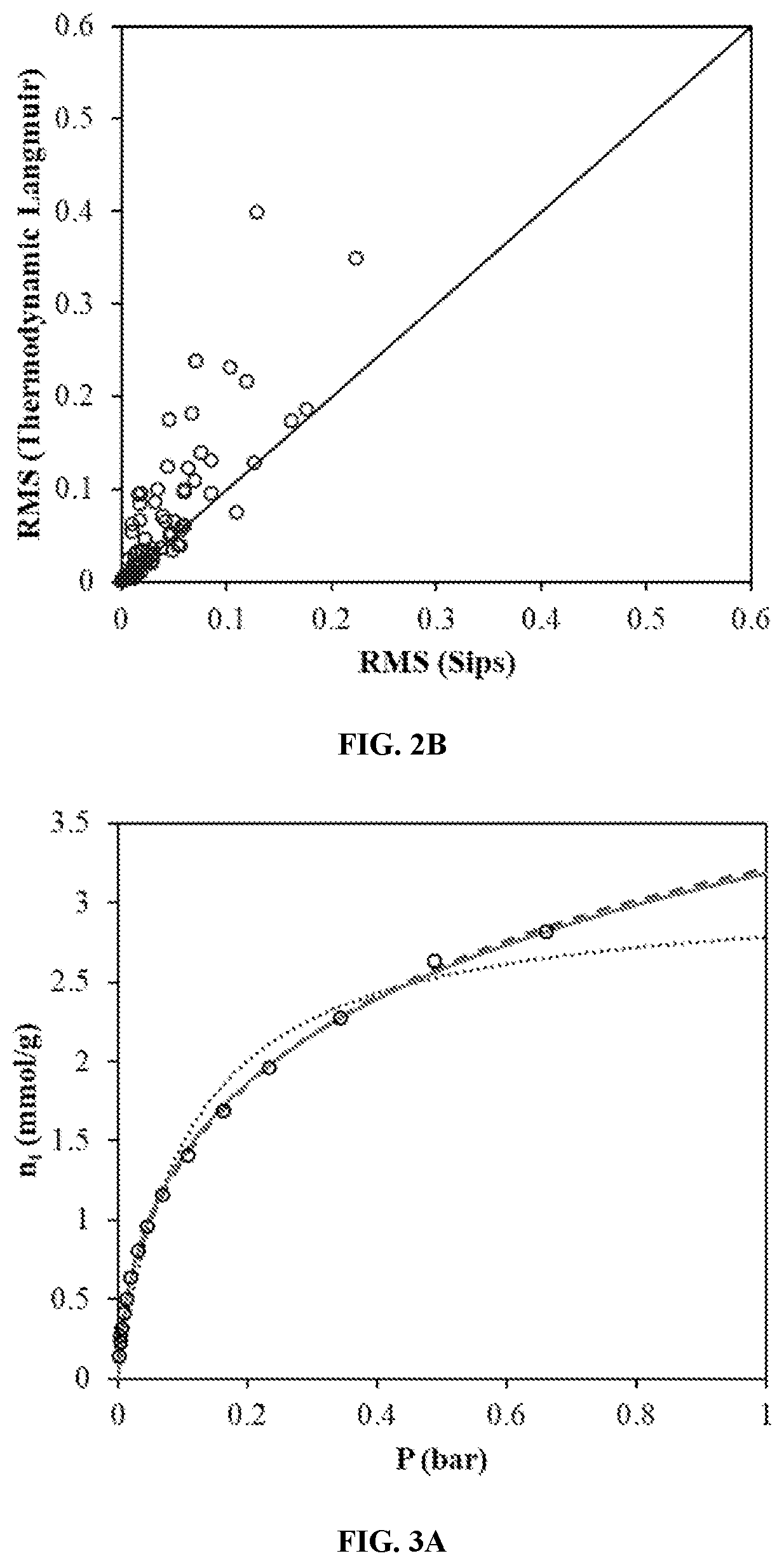Thermodynamic Formulation for Langmuir Adsorption Isotherms
a technology of adsorption isotherms and formulations, applied in the field of thermodynamic modeling, can solve the problems of loss of physical significance of langmuir isotherm parameters (n/sub>i/sub>sup>0/sup>k)
- Summary
- Abstract
- Description
- Claims
- Application Information
AI Technical Summary
Benefits of technology
Problems solved by technology
Method used
Image
Examples
example 1
Novel Langmuir Isotherm Model
[0034]Among the many efforts [12-14] to improve upon the classical Langmuir isotherm model, the empirical Sips isotherm model [12, 13] probably is the most successful one. Following Freundlich isotherm [15, 16], Sips introduced an empirical “heterogeneity” parameter m, which is usually less than unity [17], to the Langmuir isotherm. Shown in Eq. 2, the resulting
[0035]Sips isotherm expression is much more flexible in representing adsorption isotherm data.
ni=ni0(KP)m1+(KP)m(2)
[0036]With three adjustable parameters (ni0, K and m), the Sips isotherm expression and other similar empirical expressions are capable of correlating pure component adsorption isotherm data much better than the Langmuir isotherm could achieve with two adjustable parameters (ni0 and K). However, the introduction of empirical heterogeneity parameter m distorts the theoretical basis of the classical Langmuir isotherm and the physical significance of the Langmuir isotherm parameters (ni...
example 2
Difficulty in Capturing the Adsorption Behavior with the Classical Langmuir Equation Especially at Low Temperatures and High Pressures
[0072]FIGS. 8A to 8C show the Langmuir isotherm captures the adsorption behavior qualitatively at low temperatures while the semi-empirical Sips model captures the experimental data quantitatively at the expense of physical significance of the Langmuir isotherm parameters.
[0073]FIGS. 8A to 8C show the correlation results with the classical Langmuir isotherm and the Sips isotherm models: (FIG. 8A) CO2 / Activated carbon [1] at 212.7 K (FIG. 8B) CO2 / Zeolite 5A [2] at 228 K and (FIG. 8C) CO2 / Zeolite 5A [2] at 272 K. Experimental data (), Langmuir model (), and Sips model ().
[0074]FIGS. 9A to 9C show demonstrates that the thermodynamic Langmuir is comparable to the Sips model at low temperatures while retaining physical significance of the parameters.
[0075]FIGS. 9A to 9C show the correlation results with the classical Langmuir isotherm, the Sips isotherm, a...
references — example 1
REFERENCES—EXAMPLE 1
[0087][1] J.-R. Li, R. J. Kuppler, and H.-C. Zhou, “Selective gas adsorption and separation in metal-organic frameworks,” Chemical Society Reviews, vol. 38, pp. 1477-1504, 2009.
[0088][2] A. Myers and J. M. Prausnitz, “Thermodynamics of mixed gas adsorption,” AIChE Journal, vol. 11, pp. 121-127, 1965.
[0089][3] P. M. Mathias, R. Kumar, J. D. Moyer, J. M. Schork, S. R. Srinivasan, S. R. Auvil, et al., “Correlation of multicomponent gas adsorption by the dual-site Langmuir model. Application to nitrogen / oxygen adsorption on 5A-zeolite,” Industrial & Engineering Chemistry Research, vol. 35, pp. 2477-2483, 1996.
[0090][4] A. L. Myers, “Prediction of adsorption of nonideal mixtures in nanoporous materials,” Adsorption, vol. 11, pp. 37-42, 2005.
[0091][5] O. Talu and I. Zwiebel, “Multicomponent adsorption equilibria of nonideal mixtures,” AIChE Journal, vol. 32, pp. 1263-1276, 1986.
[0092][6] K. S. Walton and D. S. Sholl, “Predicting multicomponent adsorption: 50 years of t...
PUM
| Property | Measurement | Unit |
|---|---|---|
| activity coefficient | aaaaa | aaaaa |
| saturation pressure | aaaaa | aaaaa |
| Langmuir isotherm | aaaaa | aaaaa |
Abstract
Description
Claims
Application Information
 Login to View More
Login to View More - R&D
- Intellectual Property
- Life Sciences
- Materials
- Tech Scout
- Unparalleled Data Quality
- Higher Quality Content
- 60% Fewer Hallucinations
Browse by: Latest US Patents, China's latest patents, Technical Efficacy Thesaurus, Application Domain, Technology Topic, Popular Technical Reports.
© 2025 PatSnap. All rights reserved.Legal|Privacy policy|Modern Slavery Act Transparency Statement|Sitemap|About US| Contact US: help@patsnap.com



